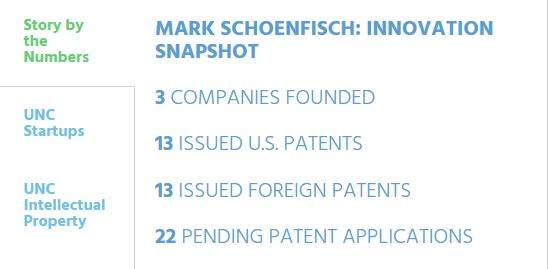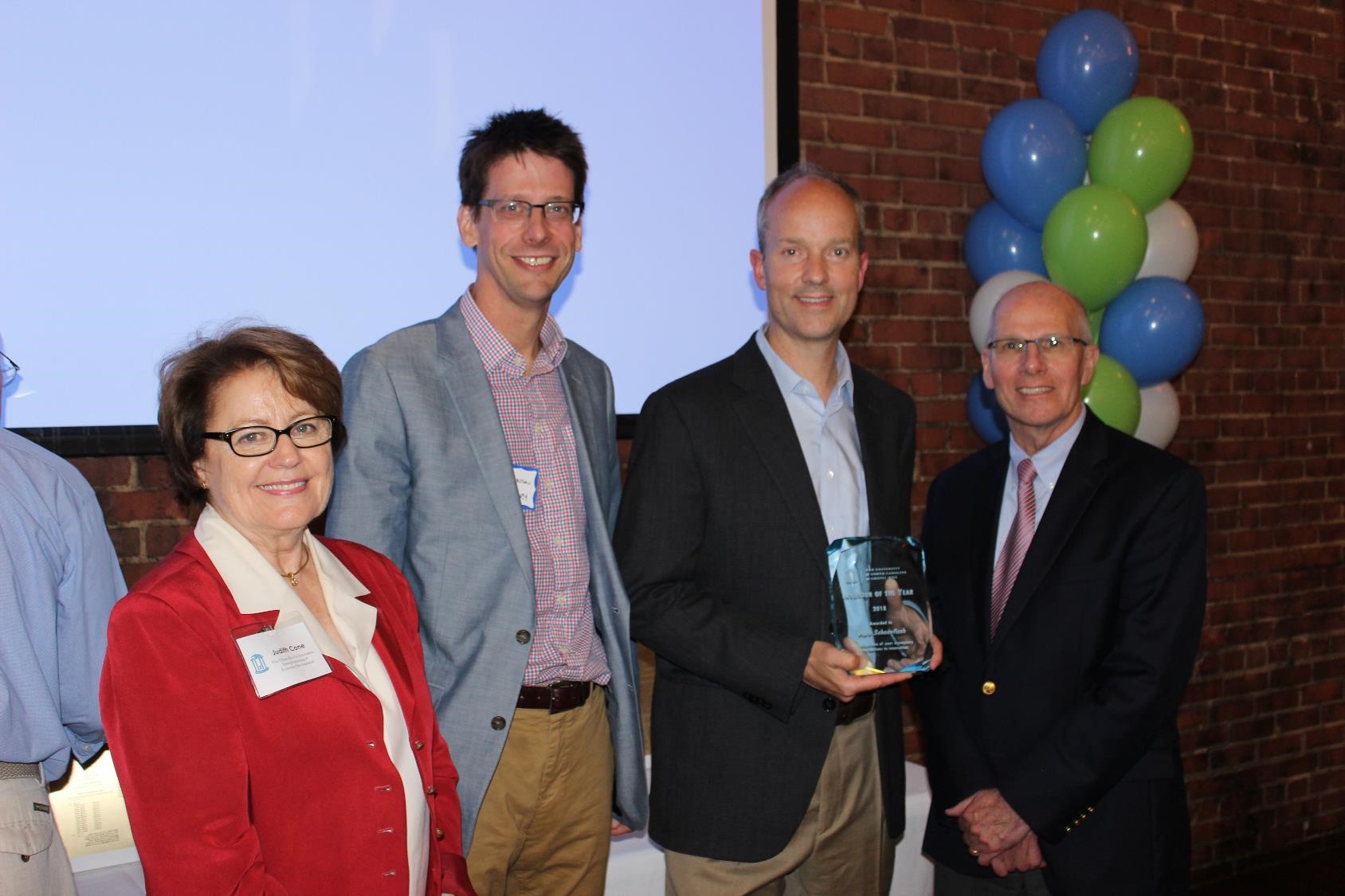
While receiving the 2018 UNC-Chapel Hill Inventor of the Year award, Mark Schoenfisch, professor of chemistry in the College of Arts & Sciences, discussed his decades-long research of the molecule nitric oxide. Schoenfisch has a record of bringing his research to market, where it has the potential to improve the lives of patients through medical devices, pharmaceutics and drug development.
Mark Schoenfisch likes to quip that his favorite letters are “N” and “O.” That might seem like a surprising preference for a chemistry professor who teaches his students to explore new scientific possibilities and whose own entrepreneurial spirit leads him to develop life-improving inventions. Yet, when you hear Schoenfisch explain that his fondness for these two letters isn’t based on the word that they form or a contrarian perspective on the world, but rather his passion for researching the molecule nitric oxide (NO), you make the connection. Through his research, he’s discovered a number of potentially huge medical benefits associated with this tiny molecule and is inventing novel ways for using nitric oxide to make a positive difference in the lives of many.
 “I’ve spent decades of work on nitric oxide, and I continue to do so because it’s rich with important chemistry problems to solve,” said Schoenfisch, a professor of chemistry at the University of North Carolina at Chapel Hill. “It extends into medical devices, pharmaceutics and drug development. I’m lucky to have picked an interesting molecule and area of study.”
“I’ve spent decades of work on nitric oxide, and I continue to do so because it’s rich with important chemistry problems to solve,” said Schoenfisch, a professor of chemistry at the University of North Carolina at Chapel Hill. “It extends into medical devices, pharmaceutics and drug development. I’m lucky to have picked an interesting molecule and area of study.”
It wasn’t luck, however, that resulted in Schoenfisch being honored by the UNC Office of Technology Commercialization as the University’s 2018 Inventor of the Year. Instead, it was his commitment to innovation and his success in translating his research on nitric oxide into devices and therapeutics for patients dealing with a range of diseases: diabetes, sepsis, cystic fibrosis, dermatological conditions and others.
During the award presentation at the annual Celebration of Inventorship, Executive Vice Chancellor and Provost Bob Blouin remarked on the importance that the University places on the work of Schoenfisch and other faculty inventors like him. “One of the most important things that we can do for the people of North Carolina and the people of this country is to create that next big thing that is going to have a chance to change the world and perhaps save a life as Mark’s work is doing,” said Blouin.
Schoenfisch’s commitment has added up to 13 issued U.S. patents, 13 issued foreign patents and 22 pending patent applications. He is also the founder of three companies:
- Novan: nitric oxide-releasing particles for dermatological conditions.
- Clinical Sensors: nitric oxide-releasing glucose biosensor.
- Vast Therapeutics: nitric oxide-releasing scaffolds for respiratory disease.
“Mark’s ability to transform important research into promising inventions that make a human impact in so many areas represents a major achievement,” said Judith Cone, vice chancellor for innovation, entrepreneurship and economic development. “We congratulate and thank him for the contributions he is making in his scientific field, and also for bringing his research into the market, where his innovations can help improve the lives of those who suffer from serious diseases.”
Building a better glucose monitoring system
Two of nitric oxide’s physiological properties – its ability to reduce inflammation and to help new blood vessels develop – are ones that Schoenfisch and his team believe can give diabetes patients a better way to measure their glucose levels.
The argument for a continuous glucose monitoring system, says Schoenfisch, is that when patients just use the intermittent finger-prick method, they may not capture the highs and lows of glucose levels that lead to complications. And while there are currently FDA-approved sensors on the market that can be implanted under the skin to monitor blood glucose, these devices have low accuracy, demand long stabilization periods and still require patients to perform finger pricks. These drawbacks lead to poor patient compliance.
The culprit behind the underperformance of today’s monitoring systems is the foreign body response. When the device is implanted under a patient’s skin, the area becomes inflamed, and non-vascular scar tissue forms around the sensor. This makes it difficult to accurately measure glucose levels. Nitric oxide can reduce the inflammation and scar tissue, making accurate measurements possible, says Schoenfisch.
“Our hypothesis back in 2000 and 2001 was that a slow release of nitric oxide would promote wound healing in the form of reduced inflammation and angiogenesis,” says Schoenfisch. After experimenting with numerous approaches, Schoenfisch’s lab has developed a nitric-oxide-releasing membrane that is applied to continuous glucose monitoring sensors.
These membranes are now being taken to market by Clinical Sensors, one of the companies Schoenfisch founded. The membranes have the potential to improve the accuracy of the sensors, extend their longevity and reduce the number of times diabetes patients have to prick their fingers.

Outpacing sepsis
Schoenfisch’s research on sensor membranes in the diabetes arena led to another interesting path – one that points to better diagnosis and treatment of hospital-acquired infections.
“An interesting technology that we began to evaluate the utility for was actually measuring nitric oxide,” said Schoenfisch. “What we unraveled is that we could create sensor membranes that were very sensitive to only nitric oxide.”
Because the molecule is produced as part of the human immune response to pathogens, a spike in nitric oxide in the bloodstream could tip off doctors that their patients are battling serious bacterial infections, such as sepsis.
In the case of sepsis, earlier detection could lessen the massive medical toll the disease takes. According to the Centers for Disease Control, each year 30 percent of the 1.6 million Americans diagnosed with sepsis die. It’s the tenth biggest cause of death and the No. 1 cost of hospitalization. Quite simply, the disease is a race against time.
As a focal point of Schoenfisch’s research, nitric oxide was discovered in the 1990’s to be involved in many physiological processes. For example, the molecule has anti-inflammatory and antibacterial properties and also promotes angiogenesis, which is the process through which new blood vessels form.
“Clinicians want to have an idea if a patient is septic as soon as possible,” Schoenfisch explains. “Mortality increases 8 percent for every hour treatment is delayed. If the correct antibiotic isn’t identified and treatment is not started, the ultimate outcome is death.”
It’s a big problem that led Schoenfisch and his research team to ask new questions.
“Could we monitor an increase in NO and initiate lab testing earlier?” he asks. “Or once a patient becomes septic, could we help clinicians determine if the correct antibiotic was being used to treat them by monitoring a decrease in NO?””
The answers appear to be yes. Schoenfisch and team began to coat microfluidic-based sensors that allow for the measurement of nitric oxide in very small volumes of blood, such as obtained via a finger prick. And the result is another technology that his company Clinical Sensors is moving into the commercial marketplace: a point-of-care device that allows minimally trained clinical staff in in ICUs and on the hospital floor to take real-time and direct measurements of nitric oxide.
Taking the fight to drug-resistant bacteria
It turns out, Schoenfisch notes, that nitric oxide also promises to play an important role not only in the detection of bacteria, but also the eradication of them. That possibility could prove vital in the era of superbugs.
“Bacteria are becoming more resistant to antibiotics, and that’s creating a health care crisis,” Schoenfisch remarked. He says that the bacteria-killing capabilities of nitric oxide could offer doctors a critical alternative.
Schoenfisch’s use of nitric oxide to combat bacteria took shape at Novan, a clinical-stage biotechnology company he founded in 2006 that focuses on using nitric oxide to treat dermatological and oncovirus-mediated diseases. A case in point is acne.
“With acne, nitric oxide has multiple mechanisms of action. In addition to killing the bacteria, you can reduce inflammation.”
These multi-pronged benefits of nitric oxide is a pattern he sees playing out in other diseases, such as cystic fibrosis (CF). Patients with CF suffer from chronic, difficult-to-treat respiratory infections caused by bacteria that hide in the mucus that builds up in the lungs. CF patients, who have an average lifespan of 41 years, find themselves on a difficult road – one that often includes taking up to 30 pills per day to combat airway dehydration, obstruction and infection. And as patients become resistant to antibiotics, the road can become more challenging.
“Most CF patients deal with different types of bacteria over their lifespans, and this necessitates different types of antibiotics being administered,” says Schoenfisch.
As Schoenfisch set out to explore the use of nitric oxide to combat respiratory infections in CF patients, he started creating biodegradable scaffolds made from chitosan, a substance that forms the outer layers of shellfish and mushrooms, to deliver nitric oxide into the lungs.
“The idea is that this could be nebulized into the lungs and be an alternative to antibiotics,” said Schoenfisch. “It can actually eradicate all the main bacteria that are causing infections in CF patients.”
One such bacteria is pseudomonas aeruginosa, which often builds up resistance to the antibiotics traditionally used to treat CF. Schoenfisch says that the new nitric-oxide-based treatment being developed by his startup company Vast Therapeutics offers an option beyond the normal path.
“We compared the NO-releasing chitosan to tobramycin, the given antibiotic to treat pseudomonas aeruginosa infections, and what we saw is that the NO is much more effective at killing these bacteria than tobramycin, particularly under anaerobic conditions that mimic what’s going on beneath the mucus in the CF lung,” said Schoenfisch. “We’re 100 times more effective than tobramycin.”
And the benefits don’t stop there. “We also see that treatment of mucus and sputum with our NO-releasing chitosan is actually breaking it apart and loosening it up,” said Schoenfisch. “We’re definitely an alternative to antibiotics and believe we can reduce chronic infections. We also think that this could have a potential role in loosening up the airway obstruction due to mucus.”
The ultimate hope, he says, is to reduce the number of pills CF patients take every day and to extend their lives.
And Schoenfisch is quick to point out that his success in innovation and making a difference in the lives of patients is a team effort that involves the students in his lab.
“My research group is really why I’ve been as involved as I am in these projects and have an entrepreneurial spirit,” he said. “Every time a superstar leaves, someone comes in and fills their role, so it’s been a really exciting experience.”
Story courtesy of Innovate Carolina




